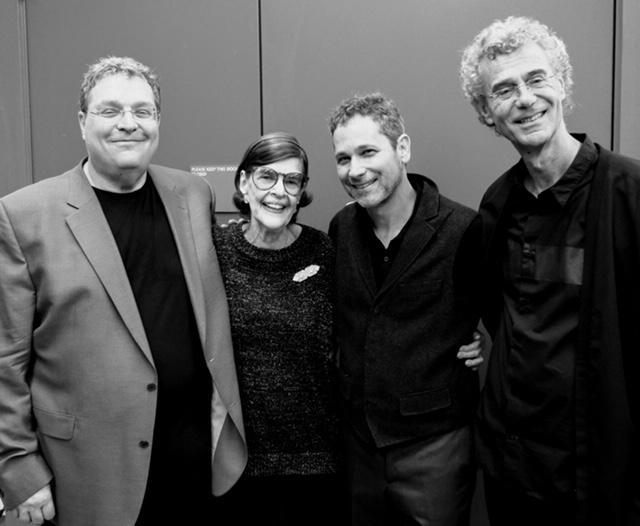An die Musik in Review
Constance Emmerich, Founder/piano; Mark Peskanov, violin; Nicholas Mann, viola;Thomas Demenga, cello; Robert Ingliss, oboe
Merkin Concert Hall, Kaufman Music Center, New York, NY
November 10, 2019
It seems almost impossible that forty-three (!) years ago, pianist Constance Emmerich founded a chamber ensemble called An die Musik (German: To Music, after the title of one of Schubert’s best-loved songs). The instrumentation of oboe, string trio, and piano permits a wide variety of program choices and sonorous variety. And here they are still (with a few changes of personnel along the way), playing to a sold-out house of admirers. This group of musicians has what I will dare to call “musical charisma,” in contrast to the “superstar” assemblages of big-name virtuosi who barely know each other and lack sufficient time to rehearse, playing on the same stage at the same time but without true collegiality. An die Musik is diametrically opposed to that, although its components are no slouches in the virtuoso department.
You know you’re at a conservatively programmed event when the outlier is Britten from 1951. Nevertheless, An die Musik’s enthusiastic, if somewhat elderly, following lapped it up, uttering great, deserved cheers. The players currently on the roster all have impressive pedigrees in contemporary music, and the ensemble has a wonderful list of commissions and adventurous programming—it might have been nice to hear some of that. I also would have liked to hear the oboe playing with the strings, and more piano-inclusive ensemble works.
The concert opened with an excerpt from one of Haydn’s great piano trios, the one in F-Sharp minor, Hob. XV/26, the same tonality as his “Farewell” symphony. But why play just the Adagio, beautiful as it is? Taken out of context, we lose the sense of an oasis between two extremely active, almost frantic movements. The Adagio is an unusual instance of self-borrowing in Haydn’s output, the melody having already appeared in his Symphony No. 102 in B-flat major from 1794. The mellow sonorities of the three players were a marvel, and their harmonic sensitivity was keen.
This was followed by the Bach/Marcello Adagio from BWV 974, played by cello and piano, from a keyboard transcription by Bach of an oboe concerto by Marcello. Although I am no youngster, I felt strangely hip in recognizing that the movement figured large in the 2015 soft-core film Fifty Shades of Grey. Thus, as rhapsodically played as it was by the superb Thomas Demenga on cello, with beautiful cushioned chords provided by Ms. Emmerich, it had for me an erotic subtext.
The concert continued with an excellent performance of a rarity, Benjamin Britten’s Six Metamorphoses After Ovid, for solo oboe, Op. 29 (1951). These brief programmatic works purport to illustrate six of the transformations in Ovid’s retelling of classic Greek myths: Pan, Phaeton, Niobe, Bacchus, Narcissus, and Arethusa. Somehow I think that if one didn’t know the titles, it wouldn’t matter, perhaps a good indicator for any “program” music. Robert Ingliss, the oboist, had great control, and Britten allows the listener to follow the thread by masterfully “metamorphosing” the opening melodic gambit of each movement with subtly developing variations upon each repetition. Even the perky moments are predominantly lyrical, sometimes ending with quizzical stops.
The first half concluded with a guaranteed barn-burner: the Handel/Halvorsen Passacaglia for violin and cello, another transcription, this time from a harpsichord suite by Handel. Mark Peskanov, violin, and Mr. Derenga reveled in its every complicated virtuoso turn with great characterization and collegial wit.
After intermission came the major work of the evening, Beethoven’s String Trio in G major, Op. 9 No. 1. A relatively early work (1797/98), it exhausts the possibilities of motivic development based on the interval of the third, even extending to the key relationship between the slow movement and the other three movements. Mr. Peskanov and Mr. Derenga were joined by the wonderful violist Nicholas Mann. Their phrasing and articulation were incandescent.
It is well known that Beethoven used to take long walks in the forests and countryside for inspiration, often with a sketchbook or at least some paper. He’d return to some of his motivic ideas obsessively, over a period of many years, even decades. I was able to hear that the opening theme of the Allegro in the first movement relates exactly (transposed) to the closing theme of the finale of his Piano Trio, Op. 1 No. 1. Also, the third movement, Scherzo, of this String Trio has a motto that will become the “Muss es sein?” (Must it be?) of his final string quartet, Op. 135! The excitement of the Presto conclusion was palpable.
There’s only one An die Musik concert in New York next year. A word to the wise: get your ticket(s).

